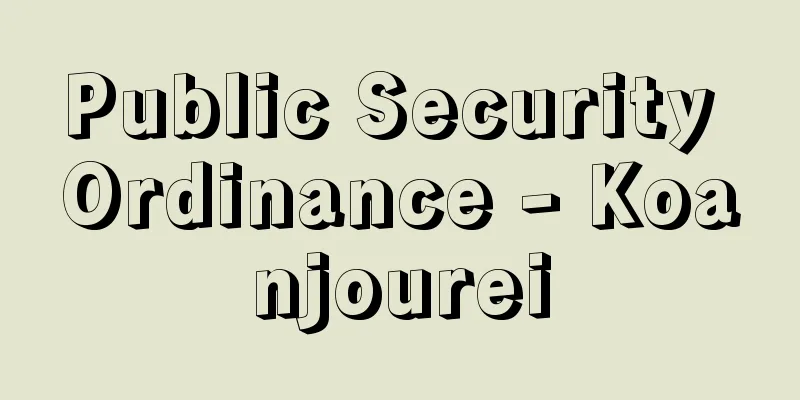Public Security Ordinance - Koanjourei

|
A common name for ordinances enacted by local governments to regulate assemblies, collective marches, collective demonstrations, etc., which are mainly held in outdoor public places, for the purpose of maintaining social and public safety and order. Although the contents of each ordinance vary slightly, they have in common that they require prior permission or notification for these collective actions, give the police the necessary authority to crack down, and impose criminal penalties on violators. In this sense, the forerunner of public security ordinances was the Osaka City Ordinance on Marches, Demonstrations, and Public Assembly, enacted on July 31, 1948 (Showa 23) by unofficial instruction of the occupying forces, and many public organizations subsequently enacted public security ordinances at the request of the occupying forces. With the promulgation of the revised Police Law in 1954, many public security ordinances were abolished, but a considerable number remain today. Whether collective actions are understood to be included in the freedom of assembly as "mobile public assemblies" or as included in "all other freedoms of expression," there is no doubt that they are guaranteed by Article 21 of the Constitution, which provides for freedom of expression. Freedom of expression is not only essential to the personality of the individual, but also forms the basis for realizing democracy, and if it is not fully guaranteed, the establishment of a democratic nation is impossible. However, collective actions involve a large number of people gathering in a certain place or marching through the streets, and therefore require coordination with the rights of other citizens. The question is whether the Public Security Ordinance will exercise caution in regulating collective actions, given their democratic significance. In its 1954 ruling on the Niigata Prefecture Public Security Ordinance, the Supreme Court ruled that the prior restraint of collective action through a general permission system was unconstitutional, but that permission or notification systems were permitted for specific locations or methods under reasonable and clear standards, and that they could only be prohibited when a clear and imminent danger to public safety was foreseen. Later, in its 1960 ruling on the Tokyo Metropolitan Public Security Ordinance, the court deviated from the above standards by discussing the theory of collective riots, and in a series of rulings in 1975, the court refrained from describing collective action as dangerous, but continued to treat it as inferior to pure speech activities. Furthermore, many public security ordinances are suspected of violating Article 31 of the Constitution (principle of criminal legality) due to the ambiguity of their wording, but the Supreme Court has shown an attitude of rejecting such arguments. [Nukazuka Yasue] [Reference items] | | |Source: Shogakukan Encyclopedia Nipponica About Encyclopedia Nipponica Information | Legend |
|
地方公共団体が、社会・公共の安全と秩序を守る目的で、主として屋外の公共の場所で行われる、集会、集団行進、集団示威運動等を規制するために定めた条例の通称。その内容は条例ごとに若干異なるが、これらの集団行動を事前の許可制ないし届出制の下に置き、所要の取締り権限を警察に与え、違反者に刑罰を科する点で共通性がある。この意味での公安条例の先駆は、占領軍の非公式指示により1948年(昭和23)7月31日に制定された大阪市の「行進、示威運動及び公の集会に関する条例」であり、その後多くの公共団体が占領軍の要請で公安条例を制定した。1954年の改正警察法公布に伴い、公安条例が廃止される例は少なからずみられたが、今日も相当数が存続している。 集団行動は、「動く公共集会」として集会の自由に含まれると解するにせよ、「その他一切の表現の自由」に含まれると解するにせよ、表現の自由を定める憲法第21条によって保障されていることは疑いない。表現の自由は個人の人格にとって不可欠であるのみならず、民主主義実現の基盤をなすものであり、これが十分に保障されていなければ、民主国家としての成立は望みえない。ただ集団行動は、一定の場所に多人数が集まり、あるいは路上を行進するものであるから、他の国民の権利との調整を必要とする。問題は、集団行動の民主的意義にかんがみ、公安条例がその規制に、慎重を期するものであるかどうかである。 最高裁判所は、1954年の新潟県公安条例判決で、一般的な許可制による集団行動の事前抑制は違憲であるとしつつも、特定の場所または方法につき合理的かつ明確な基準の下での許可制または届出制は許されるとし、公共の安全に対し明らかな差し迫った危険を及ぼすことが予見されるときにのみ禁止できるとした。その後、1960年の東京都公安条例判決で、集団暴徒化論を説いて前記の基準からの逸脱をみせ、1975年の一連の判決では、集団行動を危険視する表現は控えたが、それを純粋な言論活動に劣位させる姿勢は踏襲している。また、公安条例の多くは文言(もんごん)があいまいであることから憲法第31条(罪刑法定主義)違反の疑いがあるが、最高裁判所はかかる主張を退ける態度を示している。 [糠塚康江] [参照項目] | | |出典 小学館 日本大百科全書(ニッポニカ)日本大百科全書(ニッポニカ)について 情報 | 凡例 |
<<: Public Security Examination Commission
Recommend
Indirect crosstalk
…In addition to direct crosstalk occurring betwee...
Woodsia
…It is found widely in the mountains from Hokkaid...
Salman Schocken
1877‐1959 Jewish publisher. A German Jew from Pose...
Ridgway
American military officer. Born in Fort Monroe, Vi...
Lusitania (English spelling)
A Roman province in the western part of the Iberia...
Myra's Journal of Dress and Fashion
…The success of the English Women's Domestic ...
Goyo Hashiguchi
Woodblock artist of the Meiji and Taisho periods....
Great Ambition - Oiinaru Yabou
...Hughes became a completely different person af...
FAMOUS Project
A detailed survey of the central axis of the Mid-A...
Çerkes (Çerkez) (English spelling) Cerkes
...Also known as Adig. In English they are called...
Ono Domain - Ohnohan
A Fudai domain with a 40,000 koku stipend based i...
Chief Cabinet Secretary - Chidaijokanji
The Ryoge no Kan (official position outside the I...
Forbidden tag - inspection
A signboard that lists the terms of a prohibition....
Ammonium thiocyanate
...Used as a raw material for manufacturing dyes ...
《Female's Friend》(English)
…In Britain, various women's magazines compet...









